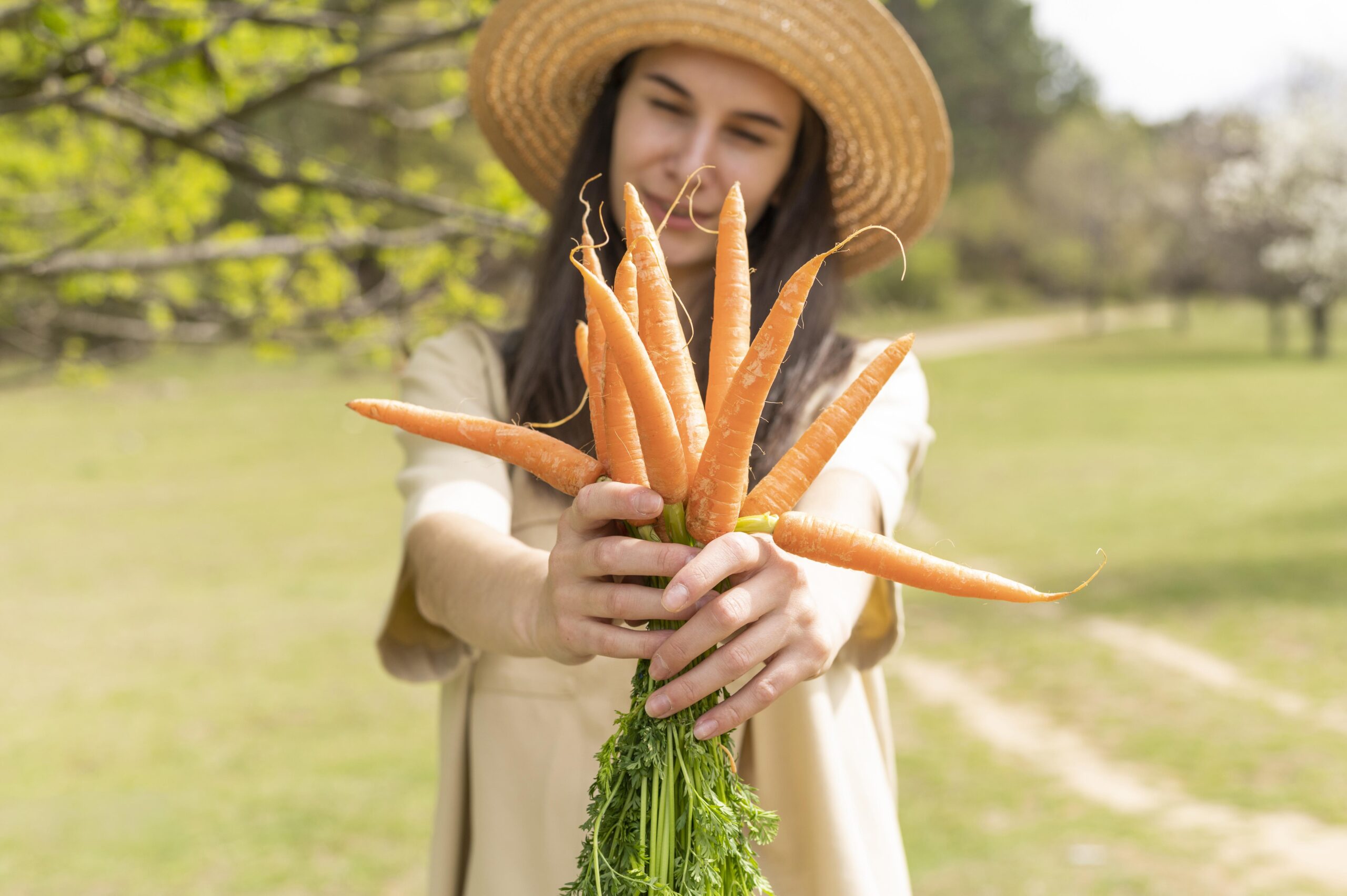What is the Best Fertilizer for Carrots? My Experience and Practical Guide
Carrots seem simple to grow, but if you’ve ever pulled up a spindly, forked root after months of care, you know they are fussier than they look.
Over the years, I learned that the secret to sweet, uniform, and healthy carrots lies in fertilizer choice and timing.
The right nutrients encourage deep root growth, while the wrong mix gives you leafy tops and tiny roots.
In this article, I’ll share what has worked best in my own garden and what science says about feeding carrots properly.
Why Fertilizer Matters for Carrots
Carrots are root vegetables, so the main focus isn’t leafy greens like lettuce or spinach — it’s the root underground. If you give carrots too much nitrogen, they’ll grow beautiful green tops but leave you with thin, stubby roots that are barely edible.
The trick is to shift the balance toward nutrients that feed the roots rather than the leaves. That’s where phosphorus and potassium come in.
The right mix of nutrients leads to:
-
Straighter, deeper roots (instead of forked or stunted ones)
-
Richer orange color (linked to better nutrition and eye appeal)
-
Sweeter flavor (more sugars stored in the root)
-
Bigger yields (you actually harvest more usable carrots)
So, fertilizer isn’t about “feeding the plant tops” — it’s about building a healthy underground root system.
Key Nutrients Carrots Need
-
Phosphorus (P):
Think of it as the “root builder.” It drives root expansion and energy transfer inside the plant. Without enough phosphorus, you’ll get spindly or deformed carrots. -
Potassium (K):
This is like the plant’s immune booster. It makes roots stronger, helps them resist disease, and also encourages sugar formation — meaning tastier carrots. -
Nitrogen (N):
Needed in moderation. A little helps the leaves stay green so they can photosynthesize and send energy down to the roots. But too much? You’ll end up with giant carrot tops and tiny, disappointing roots. -
Calcium & Magnesium:
These are supporting nutrients. Calcium helps roots grow straight and avoids splitting, while magnesium helps with photosynthesis and overall plant health. They’re not as obvious as NPK, but they make a big difference in root quality.
Fertilizer Ratios for Carrots (Reading the NPK Numbers)
Every fertilizer bag has an NPK ratio printed on it (like 5-10-10). That stands for:
-
N = Nitrogen
-
P = Phosphorus
-
K = Potassium
For carrots, you want low nitrogen but higher phosphorus and potassium. Good options are:
-
5-10-10 (balanced but tilted toward roots)
-
0-10-10 (no nitrogen at all, pure root booster)
These mixes tell your carrots: “Don’t waste energy on leaves, put everything into making plump, sweet roots.”
Types of Fertilizers That Work for Carrots
1. Granular Fertilizer
Before sowing carrot seeds, mixing a granular fertilizer into the top six inches of soil gives the roots a strong start. Carrots respond well to formulas like 5-10-10 or 4-10-10, which are low in nitrogen but rich in phosphorus and potassium. These nutrients encourage deeper, straighter roots and better flavor. The key is to apply sparingly, because too much can lead to salt buildup in the soil, which stunts carrot growth since carrots are quite sensitive.
2. Compost and Organic Matter
Carrots thrive in soil that’s loose, airy, and nutrient-rich. Adding a layer of well-aged compost before planting is one of the best ways to prepare the bed. Compost not only provides a slow, steady release of nutrients but also improves soil structure, making it easier for carrots to grow long and straight. Poor soil texture often leads to misshapen or forked carrots, so compost reduces that risk.
3. Liquid Fertilizers (Mid-Season Boost)
Carrots don’t need heavy feeding, but around six weeks after planting, when seedlings are well established, a light liquid fertilizer can give them a healthy boost. Options like fish emulsion or seaweed extract are ideal. They provide a quick shot of nutrients without overwhelming the plants. Seaweed extract, in particular, adds potassium and trace minerals, which improve root quality, sweetness, and flavor.
Fertilizers to Avoid
-
High-Nitrogen Fertilizers (e.g., 10-10-10, lawn fertilizers): These push leafy top growth but starve the roots, leaving you with big greens and tiny, disappointing carrots.
-
Fresh Manure: Applying fresh manure before planting almost always causes problems—burning seedlings with too much nitrogen and leading to forked, hairy, or deformed carrots. Instead, stick to well-aged compost for a safe and balanced nutrient source.
Carrots prefer low-nitrogen fertilizers, steady organic matter, and occasional mid-season boosts. Avoid anything too strong or fresh, and you’ll get straight, sweet, and healthy roots.
My Step-by-Step Fertilizing Routine for Carrots
Seedling Stage
During the first few weeks after germination, you let the seedlings grow without extra feeding. This is smart because carrots are slow starters and easily stressed by too many nutrients too early. Overfeeding at this stage can cause deformed roots. Allowing the seedlings to establish naturally ensures they grow evenly and adapt to the soil.
Six-Week Boost
Around six weeks in, the carrot tops are big enough to handle a gentle feeding. A diluted liquid fertilizer like fish emulsion or seaweed extract provides an immediate nutrient boost. Fish emulsion adds a small dose of nitrogen, while seaweed extract is rich in potassium and trace minerals, both of which help the roots swell and sweeten. This stage is where you start “building bulk” in the roots.
Mid-Season Check
Carrots don’t always need extra fertilizer mid-season, but you monitor their growth. If you notice pale leaves or slowed development, that’s a sign of nutrient deficiency. Instead of dumping on heavy fertilizer, you give them another light dose of liquid feed. This keeps the plants healthy without overloading the soil, maintaining balance for root growth.
Harvest Prep
About three weeks before harvesting, you stop fertilizing altogether. This final step is crucial because it allows the carrots to put their energy into concentrating sugars, which makes them taste sweeter. If you keep feeding up until harvest, the roots may grow bigger but lose that sweet, crisp flavor.
Best Fertilizer Products I Recommend
Choosing the right fertilizer makes a noticeable difference in carrot yield and flavor. After experimenting in my own garden and learning from other growers, I’ve found these products to be the most effective:
1. Espoma Garden-Tone (3-4-4)
This is an organic, slow-release fertilizer that works gently, making it safe for root crops like carrots. Its balanced nutrients encourage steady root growth without overwhelming plants. Because it releases nutrients slowly, carrots get a consistent food source throughout their growing season.
2. Down to Earth Root Vegetable Fertilizer (3-8-8)
Formulated specifically for root crops, this blend has extra phosphorus and potassium—the nutrients carrots crave for strong roots, color, and sweetness. Gardeners who’ve used it often report straighter, healthier roots compared to generic fertilizers.
3. Liquid Seaweed Extract
I like to use this as a mid-season supplement. It’s not just about the NPK ratio—it’s packed with trace minerals and natural growth hormones that boost flavor and strengthen roots. It also helps plants resist stress from heat or pests.
4. Fish Emulsion (low nitrogen formula)
When carrots need a quick energy boost, fish emulsion is my go-to. It’s gentle but effective, especially if plants look pale or sluggish. Choosing a low-nitrogen version prevents leafy tops from stealing energy away from root development.
FAQs About Fertilizing Carrots
Q1. Can I use general-purpose fertilizer for carrots?
Yes, but it’s not ideal. General-purpose fertilizers often have too much nitrogen, which causes leafy tops but stunted roots. For best results, go with a low-nitrogen, high-phosphorus, and potassium blend like 5-10-10.
Q2. How often should I fertilize carrots?
Fertilize lightly at planting time, then again about 4–6 weeks later when roots start developing. Avoid over-fertilizing—carrots are sensitive and can fork or split if given too much.
Q3. Should I use organic or synthetic fertilizer?
Both can work. Organic fertilizers like Espoma Garden-Tone or fish emulsion release nutrients slowly and improve soil health. Synthetic fertilizers act faster but require more careful handling to avoid burning roots.
Q4. Can I add compost instead of fertilizer?
Yes, well-rotted compost is excellent for carrots. Just avoid fresh manure—it’s too high in nitrogen and can cause deformed roots.
Q5. Why are my carrot tops huge but roots are small?
This usually means too much nitrogen. Switch to a low-nitrogen fertilizer and focus on phosphorus and potassium to encourage strong root growth.
Q6. Do carrots need liquid fertilizer?
Liquid fertilizers like seaweed extract or fish emulsion are great for quick feeding, especially if plants look stressed. They’re best used as supplements, not the main fertilizer.
Q7. What’s the best fertilizer ratio (NPK) for carrots?
Look for blends like 5-10-10 or 0-10-10—these encourage healthy root development and sweetness while keeping leafy growth in check.
Q8. Can I over-fertilize carrots?
Yes. Over-fertilizing often leads to forked, twisted, or split roots. Always follow label instructions and remember—carrots thrive better on slightly less fertilizer than too much.
Final Thoughts
The best fertilizer for carrots is one that supports the roots first, leaves second. For me, the winning formula has always been compost plus a phosphorus and potassium-rich fertilizer. With the right balance, I consistently harvest carrots that are crisp, sweet, and uniform.
If you’ve struggled with small or twisted carrots, chances are the fertilizer (and soil preparation) is the missing piece. Experiment with low-nitrogen blends, organic compost, and mid-season liquid feeding you’ll see the difference in both size and taste.
What about you? Have you found a fertilizer or homemade mix that works wonders for your carrots? I’d love to hear your experiences and compare notes with fellow gardeners.







